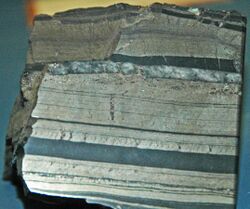Earth:Mesoproterozoic
| Mesoproterozoic | |
|---|---|
| 1600 – 1000 Ma | |
 Banded fine-grained pyrite found in the Urquhart Shale, Australia | |
| Chronology | |
| Proposed redefinition(s) | 1780–850 Ma Gradstein et al., 2012 |
| Proposed subdivisions | Rodinian Period, 1780–850 Ma Gradstein et al., 2012 |
| Etymology | |
| Name formality | Formal |
| Usage information | |
| Celestial body | Earth |
| Regional usage | Global (ICS) |
| Time scale(s) used | ICS Time Scale |
| Definition | |
| Chronological unit | Era |
| Stratigraphic unit | Erathem |
| Time span formality | Formal |
| Lower boundary definition | Defined Chronometrically |
| Upper boundary definition | Defined Chronometrically |
The Mesoproterozoic Era[4] is a geologic era that occurred from 1,600 to 1,000 million years ago. The Mesoproterozoic was the first era of Earth's history for which a fairly definitive geological record survives. Continents existed during the preceding era (the Paleoproterozoic), but little is known about them. The continental masses of the Mesoproterozoic were more or less the same ones that exist today, although their arrangement on the Earth's surface was different.
Major events and characteristics
The major events of this era are the breakup of the Columbia supercontinent, the formation of the Rodinia supercontinent,[5] and the evolution of sexual reproduction.[6]
This era is marked by the further development of continental plates and plate tectonics. The supercontinent of Columbia broke up between 1500 and 1350 million years ago,[5] and the fragments reassembled into the supercontinent of Rodinia around 1100 to 900 million years ago, on the time boundary between the Mesoproterozoic and the subsequent Neoproterozoic.[7] These tectonic events were accompanied by numerous orogenies (episodes of mountain building) that included the Kibaran orogeny in Africa;Cite error: Closing </ref> missing for <ref> tag Though the biota of the era was once thought to be exclusively microbial, recent finds have shown multicellular life did exist during the Mesoproterozoic.[8][6] This era was also the high point of the stromatolites before they declined in the Neoproterozoic.[9]
Subdivisions
The subdivisions of the Mesoproterozoic are arbitrary divisions based on time. They are not geostratigraphic or biostratigraphic units. The decision to base the Precambrian time scale on radiometric dating reflects the sparse nature of the fossil record, and Precambrian subdivisions of geologic time roughly reflect major tectonic cycles. It is possible that future revisions to the time scale will reflect more "natural" boundaries based on correlative geologic events.[10]
The Mesoproterozoic is presently divided into the Calymmian (1600 to 1400 Mya) and the Ectasian (1400 to 1200 Mya), and the Stenian (1200 to 1000 Mya). The Calymmian and Ectasian were characterized by stabilization and expansion of cratonic covers and the Stenian by formation of orogenic belts.[10]
The time period from 1780 Ma to 850 Ma, an unofficial period based on stratigraphy rather than chronometry, named the Rodinian, is described in the geological timescale review 2012 edited by Gradstein et al.,[11] but (As of February 2017), this has not yet been officially adopted by the International Union of Geological Sciences (IUGS).
See also
References
- ↑ 1.0 1.1 Plumb, K. A. (June 1, 1991). "New Precambrian time scale". Episodes 14 (2): 139–140. doi:10.18814/epiiugs/1991/v14i2/005.
- ↑ "Meso". CollinsDictionary.com. HarperCollins. https://www.collinsdictionary.com/dictionary/english/Meso.
- ↑ "Proterozoic". Merriam-Webster Dictionary. https://www.merriam-webster.com/dictionary/Proterozoic.
- ↑ There are several ways of pronouncing Mesoproterozoic, including IPA: /ˌmɛzəˌproʊtərəˈzoʊɪk, ˌmɛzoʊ-, ˌmɛs-, ˌmiːz-, ˌmiː.s-, -ˌprɒt-, -əroʊ-, -trə-, -troʊ-/ MEZ-ə-PROH-tər-ə-ZOH-ik, MEZ-oh-, MESS-, MEE-z-, MEE-s-, -PROT-, -ər-oh-, -trə-, -troh-.[2][3]
- ↑ 5.0 5.1 Zhao, G.; Sun, M.; Wilde, S. A.; Li, S. (2004). "A Paleo-Mesoproterozoic supercontinent: assembly, growth and breakup". Earth-Science Reviews 67 (1): 91–123. doi:10.1016/j.earscirev.2004.02.003. Bibcode: 2004ESRv...67...91Z. https://www.researchgate.net/publication/222891080. Retrieved 14 February 2016.
- ↑ 6.0 6.1 Butterfield, Nicholas J. (2000). "Bangiomorpha pubescens n. gen., n. sp.: implications for the evolution of sex, multicellularity, and the Mesoproterozoic/Neoproterozoic radiation of eukaryotes". Paleobiology 26 (3): 386. doi:10.1666/0094-8373(2000)026<0386:BPNGNS>2.0.CO;2. http://mr.crossref.org/iPage?doi=10.1666%2F0094-8373%282000%29026%3C0386%3ABPNGNS%3E2.0.CO%3B2. Retrieved 12 April 2021.
- ↑ Li, Z. X.; Bogdanova, S. V.; Collins, A. S.; Davidson, A.; De Waele, B.; Ernst, R. E.; Fitzsimons, I. C. W.; Fuck, R. A. et al. (2008). "Assembly, configuration, and break-up history of Rodinia: A synthesis". Precambrian Research 160 (1–2): 179–210. doi:10.1016/j.precamres.2007.04.021. Bibcode: 2008PreR..160..179L. http://www.bdewaele.be/pdfs/Lietal_IGCP440_map_2008.pdf. Retrieved 6 February 2016.
- ↑ Troppenz, Uwe-Michael; Littkowski, Sven (3 May 2019). "The Mesoproterozoic – no "boring billion"". Iranian Journal of Earth Sciences 11 (4): 239–243. https://journals.iau.ir/article_669398_304f934dfc47fd2d6598512fba6fc30f.pdf. Retrieved 25 November 2022.
- ↑ Allwood, Abigail; Grotzinger; Knoll; Burch; Anderson; Coleman; Kanik (2009). "Controls on development and diversity of Early Archean stromatolites". Proceedings of the National Academy of Sciences 106 (24): 9548–9555. doi:10.1073/pnas.0903323106. PMID 19515817. Bibcode: 2009PNAS..106.9548A.
- ↑ 10.0 10.1 Ogg, James (June 2004). "Status of Divisions of the International Geologic Time Scale". Lethaia 37 (2): 183–199. doi:10.1080/00241160410006492.
- ↑ The Geologic Time Scale 2012. 1. Elsevier. 2012. p. 361. ISBN 978-0-44-459390-0.
External links
 |

